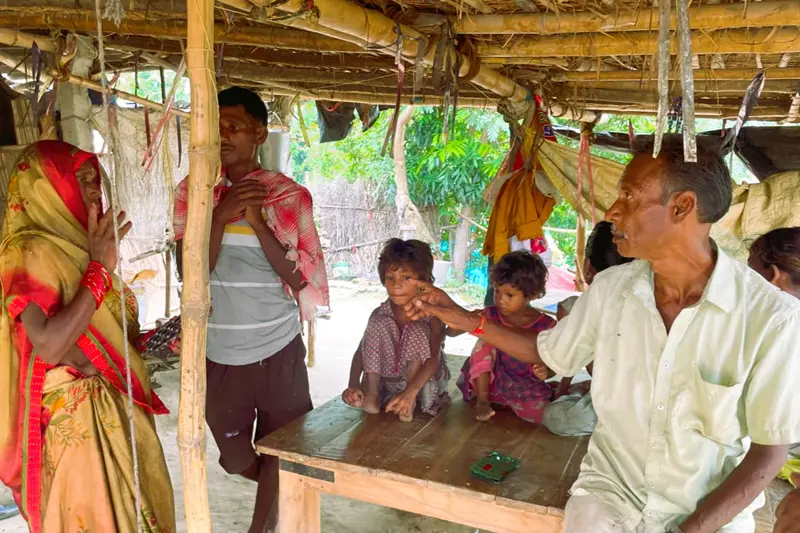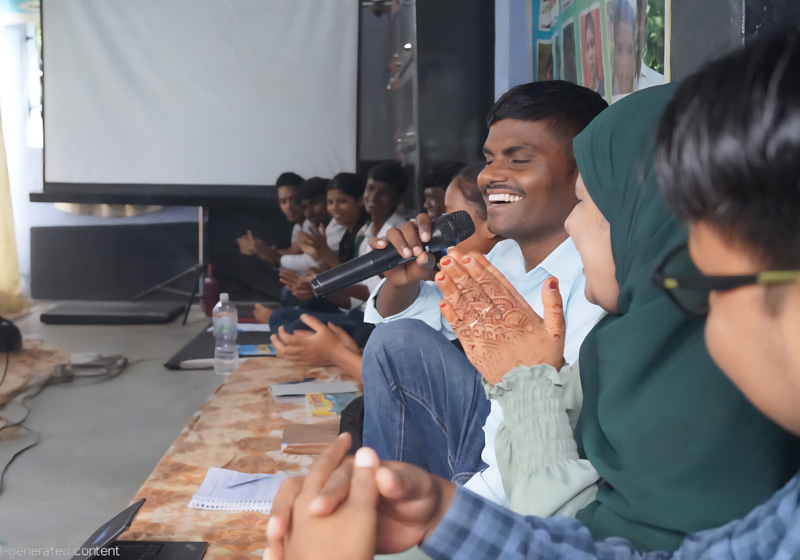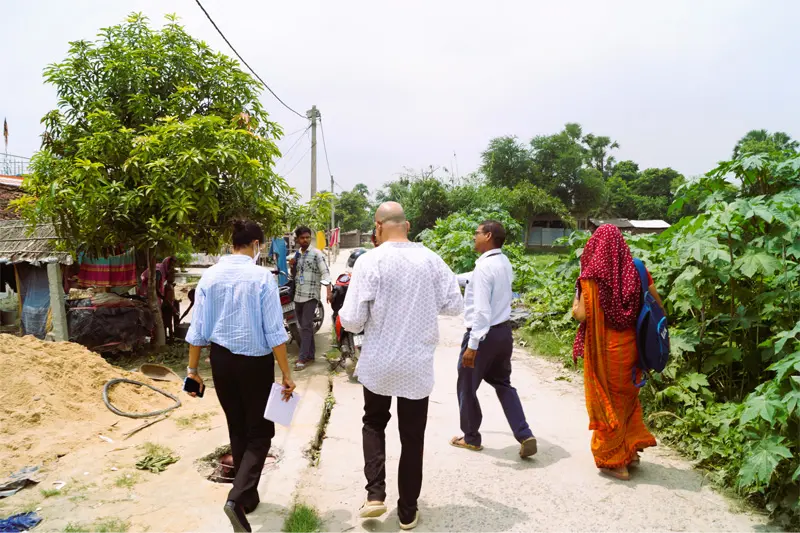
Our journey through Bihar, from Patna to Samastipur, Begusarai, Katihar, and finally Kishanganj, felt like traversing a living tapestry of India’s contrasts. Mile after mile, the car windows framed vast green agricultural lands, tranquil ponds dotted with makhana (fox nut) plants, and the occasional bustling haat (market) in small towns. We often shared the highway with processions of SUVs and jeeps festooned in party flags, election convoys barreling past in clouds of dust, a constant reminder that the state was gearing up for polls yet again. The road itself was surprisingly smooth, prompting us to marvel at Bihar’s highways. As the sun dipped and we drove onward, I soaked in the scenery and braced myself for what lay beyond the windshield: a land of proud people and perplexing paradoxes.
Melancholy on the Margins
Pulling into village after village, an unsettling feeling shadowed the trip. Despite the lively scenes – children chasing after our car, women in colorful saris working in the paddy fields, men idling at tea stalls – there was an undercurrent of despondency. It’s hard to put into words, but the faces of the people bore a certain tiredness, an expression I can only describe as “melancholic solitude” (a kind of sorrowful isolation). The lack of visible development – potholed bylanes, patchy electricity, meager shops – lent these areas a stubborn stillness.
Call it my professional bias (I’m no sociologist, just a development sector worker), but I couldn’t help sensing a collective resignation in the air. It was as if decades of unmet promises had instilled a quiet cynicism. “Hopelessness” might be too strong a word, but the mood was certainly heavy with expectation fatigue – an endless wait for change. (Bihar is objectively one of India’s poorest states, with about 33.7% of its population below the poverty line.¹) I cracked a half-hearted joke to my colleagues that “the only thing Biharis have in abundance is patience” – a grim pun reflecting how people here keep waiting for better days. Yet behind the humor lay a serious question gnawing at me: why was progress so elusive in Bihar, despite the state receiving a colossal share of federal funds year after year? After all, Bihar routinely tops the charts for central tax devolution, it now gets over 10% of India’s divisible pool of taxes, second only to Uttar Pradesh.² Driving through these underdeveloped regions felt like entering a parallel reality. All the development economics theories I’d studied were being challenged by the ground reality outside my window.
“Intehaan Ho Gayi...”: An Endless Wait
As my mind swirled with these thoughts, I sought refuge in the one thing that always brings clarity – music. Fiddling with the car radio, I landed on a golden oldie that uncannily captured the mood. In Kishore Kumar and Asha Bhosle’s charismatic voices, the classic Bollywood duet “Intehaan Ho Gayi Intezaar Ki” began to play. The lyrics made me sit up and listen:
“इन्तहा हो गई, इंतज़ार की –
आई न कुछ खबर, मेरे यार की…”
(“The wait has become endless, no news has come of my beloved…”)
At that moment, it felt as if Bihar itself was singing through the poetry of Anand Bakshi. The haunting refrain – “intehaan ho gayi, intezaar ki” (“the wait has become endless”) – resonated with the weary expressions I’d seen all day. Bihar has indeed been waiting an eternity for her fair share of prosperity. Basic amenities that many Indians take for granted – reliable power, good schools, healthcare, jobs – have remained just out of reach here. Generations of Biharis have watched their neighbors in formerly lagging states shed the “BIMARU” label and surge ahead on development indicators, while Bihar seemingly stands still, caught in a time warp.
With elections around the corner, hope flickers anew in people’s hearts – hope that this time, perhaps, their “beloved” leaders will bring the promised progress. But the song’s melancholic undertone also mirrors an underlying anxiety: a fear that this election may simply bring more of the same, another cycle of promises, not all met. As the chorus “intehaan ho gayi…” swelled, I gazed out at the dusk settling over the fields and imagined Bihar herself voicing these lyrics – “our patience has run out, we can’t wait anymore.”
Stereotypes vs. Reality: Rethinking Bihar’s Image
Traveling through Bihar also confronted us with our own preconceived notions of . lawlessness and backwardness, We found ourselves repeatedly exclaiming in pleasant surprise at things that honestly shouldn’t be surprising – like the smooth highways and new bridges. Our mental image, based on old stereotypes, was of a state with broken roads and “jungle raj” chaos. Reality proved far more nuanced.
Yes, many rural roads were still bad, but the main highways were excellent – a fact borne out by data. Bihar’s road infrastructure has expanded massively, with over 55,000 km of rural roads constructed in the last decade under government schemes.² Two-lane and four-lane highways now crisscross the state, drastically cutting travel times. We could drive from Patna to most district headquarters in under 5 hours – unthinkable 20 years ago. This infrastructure turnaround has become a point of local pride, often cited to counter the narrative of Bihar being stuck in the past.
And yet, the fact we were so impressed by something as basic as decent roads betrays the soft bigotry of low expectations – both among outsiders and Biharis themselves. One of my seniors quipped that people here have grown so accustomed to poor governance that even a proper road feels like a luxury. It’s a bittersweet irony: the state has improved in ways both big and small, but the shadow of stigma is long. Why should some Biharis have to be wary of prejudices when working in other states? This negative branding has tangible effects – from morale to investment prospects. Clearly, Bihar’s battle is not just against poverty, but also against a persistent perception problem.
Dignity vs. Development: Lessons from the Post-1990 Era
To understand how Bihar arrived at this juncture, one must rewind to a critical chapter in its history, 1990. Around that time, India as a whole was at an economic inflection point, the early 1990s liberalization unleashing market forces4. In Bihar, however, the early 1990s marked a different kind of turning point, one that reshaped the state’s socio-political fabric.
During this period, public policy and political discourse in Bihar leaned heavily toward social justice and dignity, often expressed through the slogan, “Vikas nahin, samman chahiye,” “We want respect, not development.” Scholars have noted that the state witnessed a quiet social revolution, with politics oriented toward recognition, representation, and dignity for historically marginalized communities. This shift has been described as a form of democratic deepening, where those long excluded from power asserted equal membership in the political community⁵.
The trade-off was that traditional markers of economic development, infrastructure, industry, and investment, largely stagnated through the 1990s. In many ways, the means, empowerment of the oppressed, became the end, while roads, schools, and hospitals received less attention. The outcome revealed an important lesson: representation and justice are vital, but they are not sufficient on their own to ensure livelihoods or prosperity.
More troublingly, solely replacing one ruling group with another risked creating a new cycle of hierarchy and exclusion. The feudal mindset in Bihar, of “haves” versus “have-nots,” did not vanish, and in some cases it merely shifted shape. As Munshi Premchand’s stories warn, if underlying social hierarchies remain unaddressed, the oppressed can themselves become oppressors when power changes hands. By the turn of the millennium, Bihar was caught in this bind, how to reconcile the quest for social dignity with the urgent need for economic development. The answer in subsequent years lay in striving for both dignity and development, though achieving this balance proved easier said than done.
A Reality Check: What the Data Says
Fast forward to today. Bihar in 2025 is a mixed bag of progress and persistent challenges. On one hand, there has been a turnaround since 2005 under new leadership – crime rates fell, roads were built, schools opened, and the state even notched one of the fastest GDP growth rates in the 2010s. On the other hand, Bihar still lags the nation on most human development metrics. Our desk research before the trip painted a sobering picture: Bihar has the lowest literacy rate among all states (61.8% vs. India’s ~74% as per the 2011 Census),6 some of the highest child malnutrition rates (48% of children under 5 are stunted due to chronic undernutrition), and a perennially high fertility rate (3.3 children per woman, the highest in India)7. In short, poverty, illiteracy and poor health remain endemic.
Most damning of all, inequality within Bihar remains deeply entrenched along social lines. Fresh evidence for this came via the recent Bihar caste-based survey (2023), which for the first time collected granular data on communities. The numbers were eye-opening. Scheduled Castes (Dalits) form about 19.7% of Bihar’s population and Scheduled Tribes ~1.7%. These historically disadvantaged groups still have around 43% of their households below the poverty line – an astonishing figure, roughly double the poverty rate of some better-off groups. Even among OBCs (Other Backward Classes), outcomes vary widely: some relatively influential communities have about 30% of households in poverty, whereas an extremely deprived caste like the Musahars has over 64% in poverty.8 In other words, the very people whose upliftment was the rallying cry of the 1990s social-justice politics are still largely at the bottom of the ladder. Decades of quotas, welfare schemes, and election promises have not closed these gaps.

As a monitoring and evaluation specialist, I live by the mantra “what gets measured gets managed.” Well, here the measurements are loud and clear – something isn’t working. If after 75+ years of Independence and countless poverty-alleviation programs, swathes of Bihar’s population remain so deprived, then it’s high time for some serious course correction. Yet, where is the acknowledgment?
Traveling on the ground reinforced the data. In conversations with local NGO partners, we heard of villages where government school teachers showed up once a week (if that), of primary health centers without doctors, of youths migrating en masse to Delhi or Punjab for lack of jobs. One seasoned NGO worker put it bluntly: “Bihar mein log itne aadat ke maare hain ki achchi sadak ko bhi bonus samajhte hain.” – It was a stark reminder that low expectations can perpetuate a low equilibrium – if a population stops demanding more than the bare minimum, leaders are rarely pushed to deliver more.
That night, after a long day of field visits and discussions, I collapsed into bed with my mind buzzing. We had seen hope and despair in equal measure. The question now was, what could change the script for Bihar? How do we ensure the next time I drive through these roads, the scenery of life has improved, not just the asphalt?
Finding Hope in “Dil” – The Road Ahead
Some answers, I suspect, lie hidden in the very song that became our trip’s anthem. There’s a beautiful stanza in “Intehaan Ho Gayi” sung by Asha Bhosle – and it feels almost prophetic for Bihar, especially given the singer’s first name Asha, which literally means “hope”:
“अरे, लोगों ने दिये होंगे बड़े बड़े नज़राने,
लाई हूँ मैं तेरे लिये दिल मेरा…”
(“Others may have brought you grand offerings, but I have brought you my heart… My heart prays that we’re never separated; my heart is yours.”)
These lines struck a chord. Over the years, Bihar’s people have been given plenty of grand promises (their share of “nazrana,”). What they deserve now is an “all-in” effort – a solution straight from the heart (“dil”). In other words, not half-measures or perfunctory schemes, but a wholehearted mission to transform the state. Bihar is blessed with tremendous assets waiting to be unlocked: it has some of the most fertile land in India, abundant water resources, and, notably, the youngest population in the country.6 This youthful energy, if properly directed, could become Bihar’s biggest driver of change. As the late Dr. A.P.J. Abdul Kalam once inspired us, “The ignited minds of the youth is the most powerful resource on the Earth… if properly directed, [it] will bring about transformed humanity”. Imagine what Bihar’s 2 crores+ young people could achieve with the right support and opportunities!
So, what would a truly heartfelt development roadmap for Bihar look like? For starters, it must restore belief among Bihari youths – belief in themselves and in a brighter future within their home state. This calls for a policy ecosystem that actively empowers and engages all stakeholders, from farmers and laborers to students and entrepreneurs. In corporate terms, Bihar needs a rebranding – a hard reset to shed the old image and ignite a new aspirational narrative. And this can only happen through a multi-dimensional approach that tackles the problem on several fronts simultaneously. Some agendas for this approach could be:
Spurring Inclusive Economic Growth
The engine of progress has to be a vibrant economy that creates jobs. This means aggressively encouraging entrepreneurship and investment in Bihar. The state must present itself as open for business – cut red tape, ensure law and order, and perhaps establish special economic zones to attract companies. At the same time, fostering local enterprise is crucial – micro-entrepreneurs and small businesses will bloom if given access to microfinance, mentorship programs, and business incubators.
- Investing in People – Education and Human Development
Economic strategies alone won’t work if the population isn’t equipped to participate. There needs to be a decisive leap in human development: quality education, healthcare, and skills for all. In education, integrating technology can help leapfrog constraints; digital classrooms or mobile libraries can take quality content to remote areas. Similarly, skill development programs for youth in trades, crafts, and digital skills can make them job-ready for emerging industries. Make this Bihar’s top priority, on par with economic growth; the two reinforcing each other in a virtuous cycle.
Underlying these agendas is a need to infuse aspiration and pride back into the people. Bihar’s renaissance will ultimately be driven by Biharis themselves – when a critical mass starts believing in change, they will demand it and make it happen. The role of policymakers and us “development professionals” is to catalyze this process, to throw our weight behind the initiatives that give maximum agency to the citizens. As a famous movie dialog goes, sometimes to make the right decision, “you must use your brain but follow your heart.” Here, the heart (dil) symbolizes empathy and full commitment – treating Bihar’s revival not just as a technocratic project, but as a passionate mission.

A Collective Responsibility – Dil se, Hindustan
Lastly, one might ask – Why should the rest of us care about Bihar’s fate? Why should an average Indian, or even I as an individual, be so invested in fixing what some dismiss as a “failed state”? Apart from basic human solidarity, there’s a philosophical argument I often return to, from the eminent philosopher John Rawls. Rawls proposes the idea of the “veil of ignorance”, imagine you had to design a society not knowing what position you’d be born into (rich or poor, upper caste or lower caste, Bihar or Bangalore).9 Behind this veil, any rational person would craft fair and equitable rules, since there’s a chance you’d end up at the bottom. By that logic, Bihar’s children could have been our children. If we believe in justice, we owe our fellow citizens a society where birthplace doesn’t condemn one to misery. A rising tide in Bihar will lift India as a whole, after all, one in every 13 Indians is a Bihari, and who knows what geniuses and leaders lie untapped in those floodplains for lack of opportunity?

As our road trip came to an end in the border town of Kishanganj, I felt a mix of optimism and urgency. Optimism, because despite everything, Bihar’s story is still being written – its youth, its resilient women, its rich culture are cause for hope. Urgency, because the patience of its people has indeed run out; we cannot ask them to keep waiting indefinitely for the dignity and quality of life that every Indian deserves. The echoes of “Intehaan ho gayi…” still linger in my mind – a poetic reminder that the waiting must end now. It’s time to turn up the volume, roll down the windows, and collectively sing a new tune for Bihar, one of empowerment, growth, and hope, dil se (from the heart). With both empathy and action, head and heart, let’s ensure that in the next verse of Bihar’s saga, the only thing that’s “intehaan” (extreme) is its success.
Author: Naman Shandilya
Bibliography
- UNICEF India, “Children in Bihar,” UNICEF India, https://www.unicef.org/india/children-bihar.
- “15th Finance Commission’s Tax Share Rejig Boosts Bihar, Maharashtra; Karnataka Hit: Finance Ministry,” Mint, https://www.livemint.com/economy/15th-finance-commission-tax-share-rejig-bihar-maharashtra-karnataka-hit-ministry-government-11755084082087.html.
- “55,000 km of Rural Roads Built in Bihar in 10 Years, Says PM,” The Times of India, https://timesofindia.indiatimes.com/city/patna/55000km-of-rural-roads-built-in-bihar-in-10-years-says-pm/articleshow/121978698.cms.
- “Let There Be Reform: When Historic Budget Speech by FM Manmohan Singh Set Stage for India’s Perestroika,” Down To Earth, December 27, 2024, https://www.downtoearth.org.in/governance/let-there-be-reform-when-historic-budget-speech-by-fm-manmohan-singh-set-stage-for-indias-perestroika.
- Indrajit Roy, “Why Development in Bihar Is About Social Justice,” The Wire, November 9, 2015, https://m.thewire.in/article/politics/why-development-in-bihar-is-about-social-justice.
- Office of the Registrar General & Census Commissioner, India, Census of India 2011: Provisional Population Totals—Bihar (Patna: Directorate of Census Operations, 2011), https://dse.bihar.gov.in/Source/Provisional%20Population%20Totals%202011-Bihar.pdf.
- International Institute for Population Sciences (IIPS) and ICF, National Family Health Survey (NFHS-5), 2019–21: India (Mumbai: IIPS, 2021), https://dhsprogram.com/pubs/pdf/FR375/FR375.pdf.
- Education for All in India, “Bihar Caste Census: A Comprehensive Analysis and Its Political Implications,” Education for All in India, November 2023, https://educationforallinindia.com/bihar-caste-census-a-comprehensive-analysis-its-political-implications-november-2023/.
- Ethics Unwrapped, University of Texas at Austin, “John Rawls and the Veil of Ignorance,” Ethics Unwrapped, https://ethicsunwrapped.utexas.edu/glossary/veil-of-ignorance.

